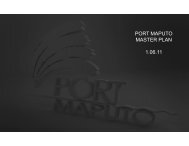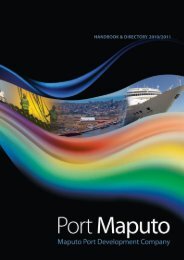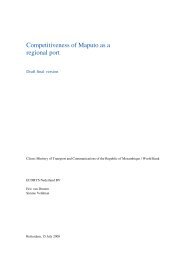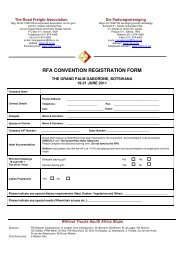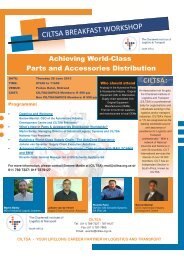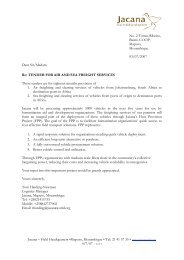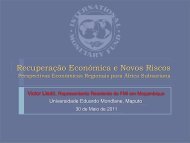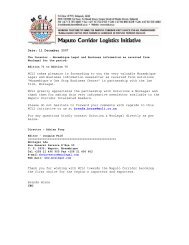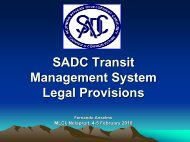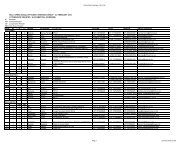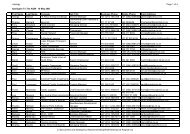Maputo Corridor Logistics Initiative - MCLI
Maputo Corridor Logistics Initiative - MCLI
Maputo Corridor Logistics Initiative - MCLI
You also want an ePaper? Increase the reach of your titles
YUMPU automatically turns print PDFs into web optimized ePapers that Google loves.
<strong>Maputo</strong> <strong>Corridor</strong> <strong>Logistics</strong> <strong>Initiative</strong><br />
Transnet Freight Rail<br />
October 2008<br />
Alex Masianoga
<strong>Maputo</strong> <strong>Corridor</strong> Defined<br />
Beit Bridge<br />
• Joint initiative formed in 2006 to restore capacity and<br />
optimise the efficiency of rail operations on the corridor<br />
Pretoria<br />
Johannesburg<br />
<strong>Maputo</strong><br />
• The Governments of the two countries have expressed<br />
Sishen<br />
Richards Bay<br />
Durban<br />
their intent to develop the “<strong>Maputo</strong> <strong>Corridor</strong>”<br />
East London<br />
• The Chief Executives of CFM and Transnet freight rail are<br />
Saldanha<br />
Cape Town<br />
Mossel Bay<br />
PE<br />
Coega<br />
committed to this development<br />
• Task teams from both Railway Administrations have been<br />
tasked to give effect to this commitment<br />
• Traffic Increase predicated on shorter transport distance<br />
TFR and CFM Business Model based on:<br />
• TCM traffic consigned to TCM Matola<br />
utilising Transnet Freight Rail locomotives<br />
and general traffic consigned from and to<br />
Komatipoort on the CFM network utilising<br />
CFM Locomotive power.<br />
to <strong>Maputo</strong> from Gauteng Hub<br />
www.transnet.net 2
<strong>Maputo</strong> <strong>Corridor</strong> – Defined<br />
Phalaborwa<br />
Steelport<br />
Nelspruit<br />
Pretoria<br />
Greenview<br />
Ogies<br />
Middelburg<br />
Witbank<br />
Belfast<br />
Kaapmuiden<br />
Kpmatipoort<br />
Ressano Garcia<br />
Moamba<br />
Machava<br />
<strong>Maputo</strong><br />
Barberton<br />
Matola<br />
Swaziland<br />
Sentrarand 3kv DC<br />
Diesel<br />
www.transnet.net 3
<strong>Maputo</strong> <strong>Corridor</strong> – Business Model<br />
• The business model between Transnet Freight Rail and<br />
CFM currently based on:<br />
• TCM traffic consigned to TCM Matola utilising Transnet<br />
Freight Rail locomotives and general traffic consigned from<br />
and to Komatipoort on the CFM network utilising CFM<br />
Locomotive power.<br />
• The Port of <strong>Maputo</strong> is a complementary port and not a<br />
competitor port to South-African ports. The Port of <strong>Maputo</strong><br />
and its links to the hinterland are an integral part of the<br />
logistical transportation chain of Southern Africa as a whole.<br />
• The Ressano Garcia line is regarded a cost-effective route<br />
from Mpumalanga and certain Gauteng areas for commodities<br />
such as steel, coal, ferrochrome, magnetite, phosphate rock,<br />
cement, granite, citrus and container exports and imports.<br />
• Increased tonnages attained amongst other based on<br />
improved, seamless train operations on the corridor,<br />
appropriately monitored.<br />
www.transnet.net 4
Rail Progress to Date<br />
From<br />
• Historically, all trains interchanged via<br />
the <strong>Maputo</strong> corridor were vacuum<br />
brake assisted trains.<br />
• Vacuum braked trains are limited to<br />
40 x wagons per train, sub optimising<br />
tonnages conveyed.<br />
• Track infrastructure and Bridge<br />
capacity on the CFM network from<br />
Ressano Garcia to <strong>Maputo</strong>, restricted<br />
train composition to the utilisation of 2<br />
x 35 class diesel locomotives<br />
• Impact TCM traffic facilitating 30 x<br />
CMR wagons for magnetite and<br />
average 35 wagons for coal and other<br />
traffic only.<br />
Towards<br />
• Air-brake assisted trains allow for increased loading capacity.<br />
• Track infrastructure on the CFM (Ressano Garcia) line to<br />
<strong>Maputo</strong> was recently refurbished allowing conveyance of 20<br />
ton/axle loads.<br />
• Bridge capacity on the CFM network were reinforced,<br />
facilitating consignment of longer trains hauled by more<br />
locomotives per train.<br />
• Second air-brake test resulted in:<br />
• Increased number of wagons per train to 60 wagons<br />
against 30; and<br />
• Increased payload of 60 tonnes per wagon against<br />
previous average<br />
loads of 54 tons per wagon.<br />
• Increased allocation of CFR wagons for conveyance of coal,<br />
• Investment in off-loading equipment for CMR wagons at TCM<br />
for Magnetite traffic<br />
• CFM injected 10 additional locomotives for conveyance of<br />
general cargo<br />
• CFM contributed rail wagons for the conveyance of sulphur to<br />
Phalaborwa<br />
• Invested in the movement of fuel from <strong>Maputo</strong> to South –<br />
Africa (25 tank wagons)<br />
www.transnet.net 5
Cargo flows from SA<br />
• Historically, the base flow from South Africa on this corridor consisted<br />
largely of coal.<br />
• This has subsequently been supplemented with the magnetite flows<br />
from Phalaborwa.<br />
• Coal and magnetite currently represent approximately 78% of the<br />
volumes consigned to <strong>Maputo</strong>.<br />
• Significant growth has however been achieved on other commodities<br />
such as sulphur and fuel consigned from <strong>Maputo</strong><br />
www.transnet.net 6
Bi-directional rail cargo flows<br />
Commodity 2007_08 2008_09 (Apr 08 to Sep 08)<br />
Coal (TCM) 762,703 529,896<br />
Magnetite (TCM) 657,717 407,657<br />
Subtotal TCM TRAFFIC 1,420,420 937,553<br />
Gen Cargo:<br />
Containers 17,595 3,227<br />
Cement 17,168 5,956<br />
Chrome 16,387 43,845<br />
Coal EOHP 37,821 5,706<br />
Ferrochrome 179,038 70,287<br />
Iron or steel 6,552 2,759<br />
Maize 42,957 33,733<br />
Copper 6,611<br />
Citrus 4,340 14,897<br />
Granite 7,488<br />
Gypsum 1,460<br />
Sugar 92,496 61,941<br />
Other 6,302 2,644<br />
Subtotal Gen Cargo 434,755 246,818<br />
GRAND TOTAL 1,855,175 1,184,371<br />
www.transnet.net 7
Bi-directional rail cargo flows<br />
General Cargo 2007_08 2008/09 (Apr 08 – Sep 08)<br />
Molasses 38,074<br />
Fuel 46,505 51,411<br />
Fuel (Bots) 770<br />
Urea 7,696 186<br />
Bran Oats 2,220<br />
Bentonite 10,224 5,808<br />
Sulphur (PHW) 15,459 41,000<br />
Sulphur (DRC) 20,653 21,441<br />
Chemicals 535<br />
Poultry 77<br />
GRAND TOTAL 141,601 120,458<br />
www.transnet.net 8
Potential Volumes<br />
Grindrod (TCM – <strong>Maputo</strong>) Volumes<br />
2008 2009 2010<br />
Coal 1,5 mil mt 1,5 mil mt 3,0 mil mt<br />
Magnetite 1,5 mil mt 2,5 mil mt 3,0 mil mt<br />
• Other major growth areas:<br />
• Coal to <strong>Maputo</strong><br />
• Containerised traffic to <strong>Maputo</strong><br />
• Copper from the DRC to <strong>Maputo</strong><br />
• Manganese from DRC to <strong>Maputo</strong><br />
• Chrome and Ferrochrome to <strong>Maputo</strong><br />
• Sulphur from <strong>Maputo</strong><br />
• Containerised traffic from <strong>Maputo</strong><br />
www.transnet.net 9
5. Challenges<br />
• Train Operating Methodology<br />
. Operating of Longer air-brake assisted trains extended to other traffic<br />
• Adequate Capital Investment in Rolling Stock to meet demand<br />
• Investment by Transnet Freight Rail, CFM and other stakeholders (PPP) in additional<br />
wagon capacity<br />
• Rail Capacity to be aligned with terminal capacity and customer demand<br />
• Turnaround time (TAT) of wagons optimising tonnages with limited capacity<br />
• Availability and proper management of auxiliary equipment – tarpaulins, telemeters<br />
• Operational deviations<br />
. Overhead power failure<br />
. Delayed off-loading<br />
. Scheduling and availability of adequate train personnel<br />
• Market fluctuations and commodity Cycles<br />
www.transnet.net 10
GOBA CORRIDOR OPERATIONS<br />
INTRODUCTION<br />
• The Goba <strong>Corridor</strong> starts from Matsapha in Swaziland, being the heart of industrial<br />
activity in Swaziland, with a number of factories producing goods for export.<br />
• The Goba <strong>Corridor</strong> leads to <strong>Maputo</strong> Port for export to overseas markets.<br />
• The rail distance from Matsapha to <strong>Maputo</strong> is 230 km.<br />
The interchange point is Mlawula in Swaziland, being 13 km from the Mozambique border.<br />
TRAIN OPERATIONS<br />
• Operations conducted i.t.o. a Business Agreement concluded between Swaziland Railway and<br />
Mozambique Railways & Ports (CFM). There is also an Operational Agreement which is an<br />
addendum to the Business Agreement. The Operational Agreement focuses on operational issues,<br />
such as the interchange point and handover procedures. Inspections are done at this interchange<br />
point.<br />
• While CFM is conducting train operations to the interchange station,It has also been agreed that in<br />
the event CFM is not able to operate trains to Mlawula for various reasons, SR would operate the<br />
trains to <strong>Maputo</strong> using SR equipment and personnel.<br />
• The two railways are working towards full integration of the train service.
COMMODITIES CONSIGNED ON THE GOBA CORRIDOR<br />
The major commodity conveyed has been sugar, however, from April 2007 export containers<br />
are now consigned on this corridor. Tonnages of the two commodities are given below.<br />
2007 2008<br />
Sugar 107,728 106,000 (est. season not finished)<br />
Containers 41,001 24,400 ( up to 08/2008)<br />
Furthermore cement is imported from <strong>Maputo</strong> via the corridor . The quantities are limited (700<br />
tonnes plus per month).<br />
CORRIDOR MANAGEMENT GROUP<br />
In accordance with the Southern Africa Railways Association (SARA) policies and procedures, SR and CFM<br />
established the Goba <strong>Corridor</strong> Management Group. This Group meets once every quarter and they<br />
address operational, technical, marketing and safety issues.
LIAISON MEETINGS<br />
• Every quarter SR and CFM Senior Management meet to address strategic issues such<br />
as investment in infrastructure, equipment, and telecommunications.<br />
• The two railways also exchange information on developments taking place within<br />
each railway such as restructuring and the privatization/concessioning of railways.<br />
.<br />
RE-LAUNCH OF THE GOBA CORRIDOR<br />
• On the 20th & 21st August, 2008 SR and<br />
CFM customers and various stakeholders<br />
• participated in the promoting of the<br />
Goba corridor and <strong>Maputo</strong> Port.<br />
• <strong>Maputo</strong> Port being the nearest port to<br />
Swaziland, focus is given to the competitive<br />
• advantage based on beneficial transport<br />
costs of export and import goods<br />
compared<br />
• to other ports
Thank you



